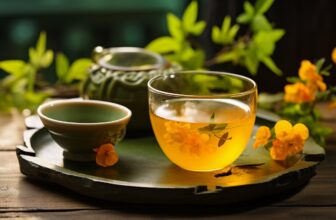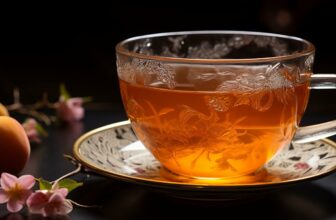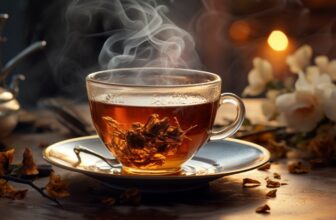
Ever scratched your head, curious about the intriguing history or unique production process of Earl Grey tea? As a seasoned tea lover myself, I embarked on a journey to demystify this favored blend.
Famous for its distinct flavor infused with bergamot orange – an Italian citrus fruit – Earl Grey has more than meets the eye. In this blog post, we’ll take you on an expedition through time and taste, delving into what makes Earl Grey so special and how it comes to life.
Ready for a personal exploration in “tea-ology”? Dive right in!
Key Takeaways
- Earl Grey tea is a type of black tea flavored with bergamot orange, which gives it a distinct and refreshing taste.
- The origins of Earl Grey tea are somewhat mysterious, but it is believed to have been named after Charles Grey, the 2nd Earl Grey and British Prime Minister in the 1800s.
- Earl Grey tea is made by infusing black tea leaves with bergamot oil or citrus extract from the bergamot fruit. The specific types of tea and amount used can vary.
- Drinking Earl Grey tea offers health benefits such as boosting the immune system, protecting oral health, detoxifying the body, improving heart health, providing an energy boost, aiding digestion, and hydrating the body.
History of Earl Grey Tea
Earl Grey tea has a rich and intriguing history, with its origins tracing back to the 19th century in England.
Origin of Earl Grey
Earl Grey tea got its name a long time ago. There was an English man named Charles Grey. He was the Prime Minister of Britain from 1830 to 1834. He did a lot of good things for his country which made him very popular.
People think that he got some black tea as a gift from China. The tea had bergamot oil in it to keep it fresh during the long trip by ship. That’s how Earl Grey Tea started!
Alternative theories
There are a few alternative theories when it comes to the origin of Earl Grey Tea. One theory suggests that it was named after Charles Grey, the 2nd Earl Grey and British Prime Minister in the 1800s.
Another theory proposes that Chinese tea merchants created the blend by infusing black tea with bergamot oil to enhance its flavor during long voyages. While these theories provide interesting insights, the true origins of Earl Grey Tea remain somewhat shrouded in mystery.
Nonetheless, they add to the allure and fascination surrounding this beloved tea variety.
Modern interpretations
Nowadays, Earl Grey tea has gone beyond its traditional form and has been given modern interpretations. Many tea companies are experimenting with different flavors and ingredients to create unique variations of this classic blend.
For example, you may find Earl Grey teas infused with other citrus fruits like lemon or orange for a tangier twist. Some brands even add floral aromas such as lavender or rose petals to enhance the flavor profile.
Additionally, there are herbal infusions that use Earl Grey as a base and incorporate various herbs and spices for added depth of taste. These modern interpretations allow tea lovers to explore new flavors while still enjoying the signature bergamot flavor that makes Earl Grey so popular.
What is Earl Grey Tea?
Earl Grey Tea is a type of black tea that gets its distinct flavor and aroma from the addition of bergamot oil, which is derived from the peel of the bergamot orange.
Definition of Earl Grey Tea
Earl Grey tea is a type of black tea that is flavored with bergamot orange, a citrus fruit. It has a distinct and refreshing flavor and aroma. The tea leaves are infused with bergamot oil or sometimes with citrus extract from the fruit itself.
Earl Grey tea can be made using different varieties of black tea, such as Keemun, Lapsang, Sri Lankan Ceylon, or Indian Assam. It is a popular choice for tea lovers looking for something different and flavorful.
Ingredients used
Earl Grey tea is made using a combination of black tea and bergamot orange. The base of the tea is typically black tea, which can be sourced from different regions such as Keemun, Lapsang, Sri Lankan Ceylon, or Indian Assam.
It is the addition of bergamot oil, extracted from the rind of bergamot oranges, that gives Earl Grey its distinct flavor and aroma. The citrus extract from the bergamot fruit adds a floral and fruity note to the tea base, creating a unique blend loved by many.
This infusion process ensures that each cup of Earl Grey tea delivers a delicious and refreshing taste experience.
Flavor and aroma
The flavor and aroma of Earl Grey tea are unique and distinct. It has a bold, rich taste with floral undertones that come from the bergamot orange. The citrusy fragrance is refreshing and invigorating, making it a delightful beverage to enjoy any time of day.
Whether you prefer it plain or with a splash of milk, Earl Grey tea offers a delightful sensory experience that is sure to please your taste buds.
How is Earl Grey Tea Made?
Earl Grey tea is made by infusing black tea leaves with the essence of bergamot, a citrus fruit, resulting in a unique and aromatic flavor. The specific type and amount of tea used can vary, as well as the type of bergamot oil or extract utilized in the production process.
Discover the fascinating preparation process and how this beloved beverage is enjoyed around the world!
Type and amount of tea used
To make Earl Grey tea, black tea is typically used as the base. Different varieties of black tea can be used, such as Keemun, Lapsang, Sri Lankan Ceylon, or Indian Assam. The amount of tea used depends on personal preference and desired strength.
Typically, one teaspoon of loose leaf tea is used per cup of water. However, you can adjust the amount based on how strong or weak you like your tea to be.
Type of bergamot used
I love Earl Grey tea because it has a unique flavor that comes from the bergamot orange. The type of bergamot used can vary depending on the brand or recipe. Some teas use natural bergamot oil, which is extracted from the rinds of fresh bergamot oranges.
This gives the tea a citrusy and slightly floral taste. Other teas may use artificial flavors or citrus extracts to achieve a similar flavor profile. Whether it’s natural or artificial, the bergamot adds a wonderful aroma and enhances the overall taste of Earl Grey tea.
Preparation process
To make Earl Grey Tea, you start with a base of black tea leaves. The most common types used are Keemun from China, Lapsang from Taiwan, Sri Lankan Ceylon tea, or Indian Assam tea.
Then comes the flavoring – bergamot oil is added to the tea leaves. This citrus extract gives Earl Grey its distinctive taste and aroma. The amount of bergamot used can vary depending on personal preference and the brand of tea you choose.
Some teas are infused with natural bergamot essence for a more intense flavor. Afterward, these ingredients are blended together to create different varieties of Earl Grey Tea such as loose leaf or tea bags.
Use as a flavoring
I love using Earl Grey tea as a flavoring in different recipes. The distinct citrusy flavor of bergamot adds a unique twist to cakes, cookies, and even cocktails. It can be infused into creams, syrups, or butter to create delightful treats with a hint of floral aromas.
The versatility of Earl Grey tea as a flavoring allows you to experiment and enhance the taste of various dishes while enjoying the soothing properties it offers.
Health Benefits of Earl Grey Tea
Earl Grey tea offers numerous health benefits, including boosting the immune system, protecting oral health, detoxifying the body, improving heart health, providing an energy boost, aiding digestion, and hydrating the body.
Boosts immune system
Earl Grey Tea is not only a delicious and refreshing beverage, but it also offers various health benefits. One of the key advantages is that it boosts the immune system. The combination of black tea and bergamot orange in Earl Grey tea contains antioxidants that help strengthen our body’s defenses.
Drinking Earl Grey tea regularly can support our immune system, making us less susceptible to common illnesses like colds and flu. So, next time you enjoy a cup of Earl Grey tea, remember that besides its delightful taste, it can also give your immune system a helpful boost.
Protects oral health
Earl Grey tea not only has a delightful flavor, but it can also help protect your oral health. The bergamot orange used to flavor Earl Grey tea contains natural compounds that have anti-inflammatory and antibacterial properties.
These properties can help reduce inflammation in the gums and prevent the growth of harmful bacteria in your mouth. By incorporating Earl Grey tea into your daily routine, you can enjoy its delicious taste while promoting better oral health at the same time.
Detoxifying properties
Earl Grey tea has been known for its detoxifying properties. It contains antioxidants that help the body eliminate toxins and promote overall wellness. The bergamot oil used in Earl Grey tea is believed to have cleansing properties that can support the liver and aid in digestion.
Drinking Earl Grey tea regularly can help flush out harmful substances from your body and keep you feeling refreshed and revitalized. So pour yourself a cup of this fragrant tea, sit back, and let it work its detoxifying magic!
Improves heart health
Drinking Earl Grey tea can have positive effects on your heart health. The combination of black tea and bergamot oil in Earl Grey has been shown to reduce the risk of heart disease.
Black tea contains antioxidants called flavonoids that help lower cholesterol levels, improve blood flow, and prevent the formation of blood clots. Bergamot oil, derived from the citrus fruit, has anti-inflammatory properties that can support cardiovascular health.
By regularly enjoying a cup of Earl Grey tea, you can contribute to maintaining a healthy heart.
Boosts energy
Drinking Earl Grey tea can give you a natural boost of energy. The combination of caffeine from the black tea and the invigorating citrus flavor of bergamot helps to increase alertness and fight fatigue.
When I drink Earl Grey tea, I feel more awake and focused, which helps me stay productive throughout the day. It’s a great alternative to coffee if you’re looking for an energy boost without the jitters or crash later on.
So, if you need a pick-me-up, grab yourself a cup of this delicious tea and enjoy the energizing benefits it provides!
Aids digestion
Drinking Earl Grey tea can aid digestion. The bergamot oil used in the tea has been known to have calming and soothing effects on the digestive system. It can help alleviate symptoms of indigestion, bloating, and gas.
So if you’re feeling a little uneasy after a big meal, a cup of Earl Grey tea may just do the trick in helping you feel better.
Hydrates the body
Drinking Earl Grey tea can help to keep your body hydrated. Hydration is essential for maintaining good overall health and ensuring that your bodily functions are working properly.
When you drink Earl Grey tea, the liquid can be absorbed by your body and replenish any fluids that you may have lost throughout the day. This makes it a refreshing choice to stay hydrated, especially during hot weather or after physical activity.
So, enjoy a cup of Earl Grey tea and quench your thirst while enjoying its delicious flavor!
Tips for Brewing the Perfect Cup of Earl Grey Tea
Brewing the perfect cup of Earl Grey tea requires high-quality water, the proper amount of tea, and careful steeping techniques.
High quality water
For the perfect cup of Earl Grey tea, it’s important to use high quality water. The water you use should be clean and free from any strong odors or flavors that could affect the taste of your tea.
Using filtered or spring water is a good idea, as tap water may contain chemicals like chlorine that can alter the flavor. So make sure you start with fresh, clean water to enhance the overall taste and enjoyment of your Earl Grey tea.
Proper amount of tea
To make the perfect cup of Earl Grey tea, it is important to use the proper amount of tea leaves. Using too much or too little can affect the flavor and strength of your brew. Generally, a teaspoon of loose leaf tea per cup is recommended.
If you prefer a stronger taste, you can add an extra half teaspoon. It’s important not to overcrowd your teapot or infuser with too many leaves, as this can result in a bitter taste.
Finding the right balance will help you achieve that delightful infusion of bergamot flavor in every sip. So remember, measure out the proper amount of tea for a truly enjoyable experience.
Steeping techniques
To make the perfect cup of Earl Grey tea, it’s important to steep it properly. Start by heating fresh water to a boil. Then, add one teaspoon of loose leaf Earl Grey tea or one tea bag into your teapot or mug.
Pour the hot water over the tea and let it steep for about 3-5 minutes. If you prefer a stronger flavor, you can steep it for longer but be careful not to oversteep as it may become bitter.
Once the time is up, remove the tea leaves or tea bag and enjoy your aromatic cup of Earl Grey!
Flavoring options
When it comes to flavoring options for Earl Grey tea, there are a few choices you can consider. One option is to add a splash of milk, which can help mellow out the strong flavors of the bergamot oil.
Another option is to experiment with different types of black tea as your base, such as Keemun or Lapsang. You can also try blending different teas together, like Sri Lankan Ceylon and Indian Assam, to create a unique flavor profile.
If you prefer a more intense citrus taste, you can even infuse your tea with fresh citrus fruits or add a few drops of citrus extract. The possibilities for customization are endless!
Who should avoid bergamot tea?
If you have a strong sensitivity or allergy to citrus fruits, it is best to avoid bergamot tea. The citrus flavor in bergamot tea comes from the oil extracted from the rind of the bergamot orange, which can cause adverse reactions in some individuals.
Additionally, if you are taking medications that could interact with the compounds found in bergamot oil, it is recommended to consult with your healthcare provider before consuming this tea.
It’s always important to listen to your body and make choices that support your health and well-being.
Conclusion
In conclusion, Earl Grey tea is a flavorful and aromatic black tea infused with bergamot oil. It has a rich history and various interpretations in the modern world. To make this delicious tea, you need high-quality black tea leaves and a specific type of bergamot orange for flavoring.
The preparation process involves infusing the tea base with bergamot oil, creating a unique beverage enjoyed by many. So why not brew yourself a cup of Earl Grey and savor its delightful taste?.
FAQs
1. What is Earl Grey Tea?
Earl Grey Tea is a famous type of tea in the British tea culture, usually made from black teas like Keemun or Lapsang.
2. How is Earl Grey Tea made?
The making of Earl Grey Tea follows the usual tea production process but includes an extra step where it is flavored with oil from the rind of bergamot orange.
3. Are there different varieties of Earl Grey Tea?
Yes, other than being made with common black teas, some unique mixes use blends from different tea varieties for a specific taste that sets them apart.
4. Can I brew my own Earl Grey at home?
Sure! With knowledge about certain tea brewing methods and the ingredients required, you can prepare your cup of aromatic and flavorsome Earl Gray right at home.





















